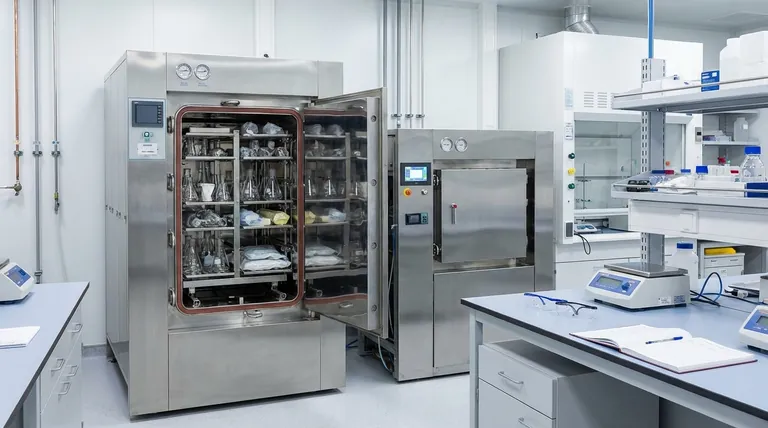The most prevalent type of autoclave is the steam sterilizer, a device that uses high-pressure steam to eliminate microorganisms. While specific models and sizes vary, the underlying principle of steam sterilization is the universal standard for sterilizing heat-resistant equipment in nearly every medical, laboratory, and research setting worldwide.
The question isn't which single autoclave model is most common, but rather which method of sterilization dominates. The answer is unequivocally steam sterilization, with the specific type of steam autoclave—gravity displacement or pre-vacuum—being chosen based on the materials being sterilized.

What Makes Steam Autoclaves the Industry Standard?
Steam autoclaves are ubiquitous for a reason. Their effectiveness, reliability, and cost-efficiency make them the default choice for a vast range of applications.
The Principle of Steam Sterilization
An autoclave works by exposing items to saturated steam at a high temperature (typically 121°C or 134°C) under pressure. This combination of moist heat is incredibly effective at transferring thermal energy.
The heat rapidly denatures the essential proteins and enzymes within microorganisms, including resilient bacterial spores, rendering them non-viable and ensuring sterility.
Unmatched Effectiveness
Steam sterilization is a highly lethal process capable of killing a broad spectrum of microbes. Its ability to destroy even the toughest bacterial spores is why it is considered the gold standard in sterilization practices.
Reliability and Cost-Effectiveness
The process is highly reliable, consistent, and relatively fast. Critically, it uses only water to generate steam, making it a non-toxic and inexpensive method compared to chemical sterilization alternatives.
Common Environments for Steam Autoclaves
The references are clear: steam autoclaves are a foundational piece of equipment across numerous professional fields where sterility is non-negotiable.
Medical and Healthcare Facilities
Hospitals, dental offices, and clinics rely on autoclaves to sterilize surgical instruments, dental tools, and other reusable medical devices. This is essential for preventing patient infections.
Laboratory and Research Settings
Microbiology, pharmaceutical, and general research labs use autoclaves constantly. They are used for sterilizing glassware, culture media, and equipment, as well as for decontaminating biohazardous waste before disposal.
Specialized Industries
The use of steam autoclaves extends to veterinary science, for sterilizing surgical tools, and to industries like tattooing and body piercing, where preventing the transmission of bloodborne pathogens is paramount.
Understanding the Trade-offs
While steam sterilization is the standard, not all steam autoclaves are the same, and the method itself has limitations. The most common distinction is how air is removed from the sterilization chamber.
The Workhorse: Gravity Displacement
This is the most fundamental and common design. Steam is introduced into the top of the chamber, and because it is less dense than air, it displaces the cooler, heavier air, which is forced out through a drain at the bottom.
These autoclaves are simple, reliable, and perfect for sterilizing uncomplicated items like laboratory glassware, media, and unwrapped solid instruments.
The Specialist: Pre-Vacuum Autoclaves
These more advanced units use a vacuum pump to actively remove air from the chamber before steam is introduced. This ensures there are no air pockets that could inhibit steam penetration.
Pre-vacuum autoclaves are essential for sterilizing complex items, such as porous materials (surgical gowns, dressings) or instruments with long, narrow lumens (hollow tubes). They offer faster cycles and more reliable sterilization for challenging loads.
The Limitation: Material Compatibility
The biggest trade-off of any steam autoclave is its reliance on high heat and moisture. It cannot be used for materials that are heat-sensitive (like many plastics) or moisture-sensitive.
Making the Right Choice for Your Goal
Selecting the correct approach requires understanding the nature of the items you need to sterilize.
- If your primary focus is general lab work (media, glassware, solid instruments): A standard gravity displacement steam autoclave is the most common and cost-effective solution.
- If your primary focus is sterilizing porous loads, wrapped surgical kits, or complex instruments: A pre-vacuum autoclave is the required standard to ensure complete steam penetration and sterility.
- If your primary focus is sterilizing heat or moisture-sensitive items: Steam autoclaving is the wrong method, and you must explore low-temperature alternatives like ethylene oxide (EtO) or vaporized hydrogen peroxide (VHP).
Ultimately, understanding the principle behind the technology is the key to ensuring you use the right tool for the job effectively and safely.
Summary Table:
| Autoclave Type | Best For | Key Feature |
|---|---|---|
| Gravity Displacement | Glassware, media, unwrapped instruments | Simple, reliable, cost-effective |
| Pre-Vacuum | Porous loads, wrapped kits, complex instruments | Ensures no air pockets for full steam penetration |
Need the right autoclave for your lab? KINTEK specializes in lab equipment and consumables, providing reliable gravity displacement and pre-vacuum autoclaves tailored to your sterilization needs. Ensure safety and efficiency in your medical, research, or industrial setting—contact us today for expert guidance and a solution that fits your goals!
Visual Guide

Related Products
- Laboratory Sterilizer Lab Autoclave Herbal Powder Sterilization Machine for Plant
- Desktop Fast Laboratory Autoclave Sterilizer 35L 50L 90L for Lab Use
- Laboratory High Pressure Steam Sterilizer Vertical Autoclave for Lab Department
- Portable Digital Display Automatic Laboratory Sterilizer Lab Autoclave for Sterilization Pressure
- Portable High Pressure Laboratory Autoclave Steam Sterilizer for Lab Use
People Also Ask
- Why is autoclave temperature 134? Achieve Rapid Sterilization for Critical Instruments
- What is the function of autoclave in tissue culture laboratory? Ensure Absolute Sterility for Successful Cell Growth
- What autoclave is used for sterilization? The Definitive Guide to Steam Sterilization
- What is the most common machine used to sterilize medical supplies? The Definitive Guide to Autoclaves
- What is an autoclave used for in a lab? Achieve Total Sterilization for Lab Safety and Integrity



















